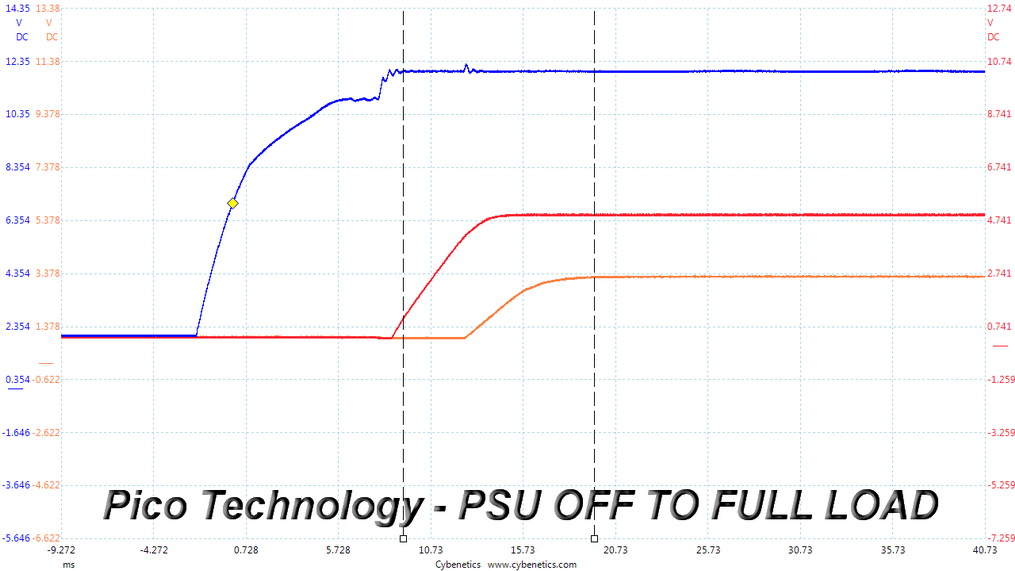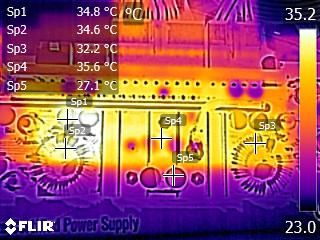Why you can trust Tom's Hardware
Protection Features
Check out our PSUs 101 article to learn more about PSU protection features.
Protection Features | |
OCP | 12V: 87.8A (141.61%), 12.027V |
OPP | 1069.34W (141.63%) |
OTP PSU / Connect Module | ✓ (132°C @ 12V Heat Sink) |
SCP | 12V: ✓ |
PWR_OK | Proper Operation |
NLO | ✓ |
SIP | Surge: MOV |
The OCP and OPP triggering points are set quite high. This might be a capable platform, but we would prefer to see within 130% thresholds. On the other hand, the over-temperature protection is configured correctly in both the power supply and the Connect module.
DC Power Sequencing
According to Intel’s most recent Power Supply Design Guide (revision 1.4), the +12V and 5V outputs must be equal to or greater than the 3.3V rail at all times. Unfortunately, Intel doesn't mention why it is so important to always keep the 3.3V rail's voltage lower than the levels of the other two outputs.

DC Power Sequencing Scope Shots


The 3.3V rail is always lower than the other two, so there is no problem here.
Cross Load Tests
To generate the following charts, we set our loaders to auto mode through custom-made software before trying more than 25,000 possible load combinations with the +12V, 5V, and 3.3V rails. The deviations in each of the charts below are calculated by taking the nominal values of the rails (12V, 5V, and 3.3V) as point zero. The ambient temperature during testing was between 30 to 32 degrees Celsius (86 to 89.6 degrees Fahrenheit).
Load Regulation Charts

Load Regulation Charts


Efficiency Chart
Ripple Charts
The lower the power supply's ripple, the more stable the system will be and less stress will also be applied to its components.

Ripple Suppression Charts



Infrared Images
We apply a half-load for 10 minutes with the PSU's top cover and cooling fan removed before taking photos with a modified FLIR E4 camera able to deliver an IR resolution of 320x240 (76,800 pixels).
Get Tom's Hardware's best news and in-depth reviews, straight to your inbox.

IR Images










The temperatures are kept at normal levels.
We wanted to see how the Connect module copes with the heat that the DC-DC converters generate, under very high loads, so we applied 100W combined on the minor rails for 30 minutes, and we took several IR images.

IR Images - Connect Module








We pushed the VRMs of the Connect module hard. Still, the temperatures at its internals were kept at low levels, proving that you won't have any overheating issues in any real-life usage scenarios.
MORE: Best Power Supplies
MORE: How We Test Power Supplies
MORE: All Power Supply Content
Current page: Protection Features, DC Power Sequencing, Cross-Load Tests and Infrared Images
Prev Page Load Regulation, Hold-Up Time, Inrush Current, Efficiency and Noise Next Page Transient Response Tests, Timing Tests, Ripple Measurements and EMC Pre-Compliance Testing
Aris Mpitziopoulos is a contributing editor at Tom's Hardware, covering PSUs.
-
Math Geek i missed this one some how before it was released. but i like the idea and do hope we get more and more of these. is a solution to something i never even thought of as a problem, but now can't imagine doing without!!Reply -
bit_user Thanks for the thorough and comprehensive review, Aris!Reply
I don't have a problem with their existing modular setup. I have 3 Seasonic modular PSUs (and one semi-modular) and have swapped two of them between machines, on a couple occasions. It was very nice to be able to swap PSUs without having to unplug, reroute, and reconnect the cables from everything - just disconnect them at the PSU end. I also like being able to borrow cables that came with one PSU to use with another.
With that said, I would use this style of setup under two conditions:
Actual PSU performance should equal or exceed their conventional models.
Cable compatibility should be retained with their existing modular PSUs.
Otherwise, I'll just stick with what's been working just fine for me, as long as they continue to be available.
